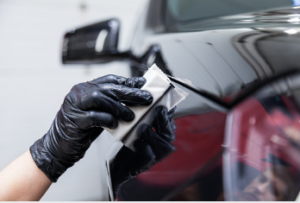Maintaining your car’s aesthetic requires a considerable amount of work. One essential aspect is protecting its paint. Doing this will extend its life considerably and also ensure it looks fantastic.
When protecting the paint on your car, there are various options. These may include wax, sealant and even ceramic coating.
 Wax
Wax
Wax is an effective way to shield your car’s paint job and increase its resale value.
Paint protection can be achieved with various waxes, such as synthetic and carnauba. Each has advantages ideal for protecting your car’s paint job.
Carnauba wax, for instance, provides a challenging and super glossy coating that’s heat resistant and repellent to water and other environmental irritants.
Similar to some waxes, harsh chemicals in some polishes can leave a white or hazy film on your vehicle’s clear coat. Due to this abrasiveness, dark-coloured cars show more scratches than lighter-coloured ones.
To guarantee you purchase the ideal wax for your car, read its packaging carefully and do your research. The label will indicate whether or not the resin is suitable for clear-coat finishes and how abrasive it is.
Many car enthusiasts opt for a combination of waxes. These mixtures often include beeswax, an organic substance that helps carnauba wax adhere to paint surfaces. Furthermore, these waxes may contain other emollients like linseed oil for additional comfort.
This blend can help the wax penetrate your vehicle’s paint, protecting it and making it last longer. Furthermore, it protects your vehicle’s paint from cracking or fading due to UV rays from the sun.
Sealant
Sealants are coatings used to shield the paint from damage. They come in both spray-on and paste forms, with various finishes such as high-gloss and matte options to meet the different needs of car owners. On average, sealants need to be applied once every 12 months for optimal vehicle aesthetics.
Before applying Cerami_Car paint protection Adelaide to your car, the surface must be thoroughly cleaned and decontaminated. Without this preparation, the sealant won’t adhere properly to the surface or provide long-lasting results.
Sealants are typically considered more durable than waxes and polishes due to their ability to block road tar, potholes, bird droppings, and other debris from eating away at a car’s paint job. Therefore, sealants are essential in protecting vehicles from road tar, potholes, bird droppings, and other contaminants that could erode at their finish.
A quality Cerami_Car paint protection Adelaide should resist abrasion and chemical attack and withstand extreme temperatures without breaking down or losing flexibility. Furthermore, it should be easy to apply and cure.
Sealants are excellent for cars, such as daily drivers, track vehicles and heavy-duty trucks. However, they’re incredibly beneficial to those who drive often or travel frequently; therefore, sealants should be reapplied at least once annually.
Ceramic Coating
The ceramic coating will fill in the microscopic pores of your car’s paint, making it harder for minor scratches and scuffs to stick to the surface. It also makes your vehicle resistant to chemical stains and etches, marks caused by acidic air pollutants in urban environments.
It is especially beneficial for those living in hot climates where dirt and mud can constantly threaten the integrity of your car’s paint. With a ceramic coating, these contaminants won’t be able to adhere to your car’s surface, allowing you to wipe them away with water after driving or washing quickly.
The ceramic coating shields your vehicle’s paint from UV rays and against oxidation and chemical etch marks. Unfortunately, these blemishes can cause your vehicle’s paint job to fade prematurely, decreasing resale value.
Plastic Protective Film
If you want to protect your car’s paint and keep it looking new, a plastic protective film might be just what you need. This transparent urethane material can be applied to almost any surface on your vehicle and help shield against multiple types of damage such as scratches, road debris and rock chips.
The initial step in applying a protective film to your car’s exterior requires a thin adhesive layer. Once dry, wait several hours for it to set. Finally, utilise an industrial heat gun and touchless instant temp reader to activate the adhesive and ensure your PPF adheres securely to your vehicle’s paint.